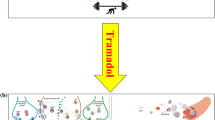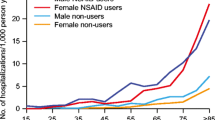Abstract
A survey of newer analgesics in advanced clinical development suggests that cyclooxygenase-2 inhibitors for inflammatory pain, newer 5-hydroxytryptamine 1D (5-HT 1D) agonists for migraine pain, α-2 adrenergics, neuron-specific Ca++or NA+ channel antagonists, drugs that potentiate opioid analgesics or inhibit morphine tolerance development, or implantation of encapsulated living cell systems that release endorphins or other analgesic peptides, may improve analgesic responsiveness and reduce side effects for some patients with acute or chronic pain conditions. Among the more novel anti-inflammatory anti-arthritic drugs with different mechanisms of action than the dominant nonsteroidal anti-inflammatory drugs are the first new cyclooxygenase-2 inhibitors (celecoxib, vioxx) and two drugs that may have combined immunomodulatory and anti-inflammatory actions (pelubiprofen, enbrel). Other anti-inflammatory, anti-arthritic approaches in earlier clinical testing include two leukotriene antagonists, a C5a complement inhibitor, and matrix metalloproteinase inhibitor.This manuscript details the need for new pain relieving drugs, presents their status, and enumerates the drugs in development.The status of new nonsteroidal anti-inflammatory drugs is described with new mechanisms of action and efficacy for acute and chronic pain use.
Similar content being viewed by others
References and Recommended Reading
Bovill JG: Mechanisms of actions of opioids and non-steroidal anti-inflammatory drugs. Eur J Anaesthesiol 14:9–15, 1997. Update on mechanisms of action.
McCormack K: The spinal actions of nonsteroidal anti-inflammatory drugs and the dissociation between their anti-inflammatory and analgesic effects. Drugs 1994, 47:28–45.
Vane JR, Botting RM: Overview-mechanisms of action of antiinflammatory drugs. In: Improved Non-steroidal Anti-inflammatory Drugs. Kluwer Academic Publishers 1996:1–27. Up-to-date on mechanisms of action of old and new anti-inflammatory drugs. What we know on selective inhibition of COX-2.
Noble S, Balfour JA: Meloxicam. Drugs 1996, 51:424–432.
Rabasseda X: Safety profile of nimesulide. Drugs Today 1997, 33(suppl).
Kehlet H, Mather LE: The value of NSAIDs in the management of postoperative pain. Drugs 1992, 44:1–63. Everything on NSAIDs up to 1992.
Nuutinen LS, Laitinen JU, Salomäki TE: A risk-benefit appraisal of injectable NSAIDs in the management of postoperative pain. Drug Safety 1993, 9:380–393.
Nuutinen L, Laitinen J, Salomäki T: The role of nonsteroidal anti-inflammatory drugs. Pain Digest 1994, 4:130–135.
Laitinen J, Nuutinen L: Intravenous diclofenac coupled with PCA fentanyl for pain relief after total hip replacement. Anaesthesiology 1992, 76:194–198.
Laitinen J, Nuutinen L, Kiiskilä EL, et al.: Comparison of intravenous diclofenac, indomethacin and oxycodone as postoperative analgesics in patients undergoing knee surgery. Eur J of Anaesthesiol 1992, 9:29–34.
Morrow BC, Bunting H, Milligan KR: A comparison of diclofenac and ketorolac for postoperative analgesia following day-case arthroscopy of the knee joint. Anaesthesia 1993, 48:585–587.
Dennis AR, Leeson-Payne CG, Hobbs GJ: A comparison of diclofenac with ketorolac for pain relief after knee arthroscopy. Anaesthesia 1995, 50:904–906.
Niemi L, Tuominen M, Rosenberg PH: Comparison of parenteral diclofenac and ketoprofen for postoperative pain relief after maxillofacial surgery. Acta Anaesthesiol Scan 1995, 39:96–99.
Kostamovaara P, Hendolin H, Kokki H, Nuutinen L: Ketorolac, diclofenac and ketoprofen are equally efficacious for the pain relief after total hip replacement surgery. Br J Anaesth 1998, in press. Prospective, randomized, double-blind trial to examine possible differences in efficacy and side effects between three NSAIDs in common use.
Morley-Forster P, Newton PT, Cook MJ: Ketorolac and indomethacin are equally efficacious for the relief of minor postoperative pain. Can J Anaesth 1993, 40:1126–1130.
Rorarius MGF, Suominen P, Baer GA, et al.: Diclofenac and ketoprofen for pain treatment after elective caesarean section. Br J Anaest 1993, 70:293–297.
Kostamovaara PA, Laitinen JO, Nuutinen LS, Koivuranta M: Intravenous ketoprofen for pain relief after total hip or knee replacement. Acta Anaesthesiol Scan 1996, 40:697–703. One of the few clinical dose-response finding studies.
Fredman B, Olsfanger D, Jedeikin R: A comparative study of ketorolac and diclofenac on post-laparoscopic cholecystectomy pain. Eur J Anaesth 1995, 12:501–504.
Author information
Authors and Affiliations
Rights and permissions
About this article
Cite this article
Nuutinen, L., Raj, P.P. An overview of current and investigational non-narcotic drugs for treatment of acute and chronic pain. Current Review of Pain 2, 187–192 (1998). https://doi.org/10.1007/s11916-998-0018-1
Published:
Issue Date:
DOI: https://doi.org/10.1007/s11916-998-0018-1




